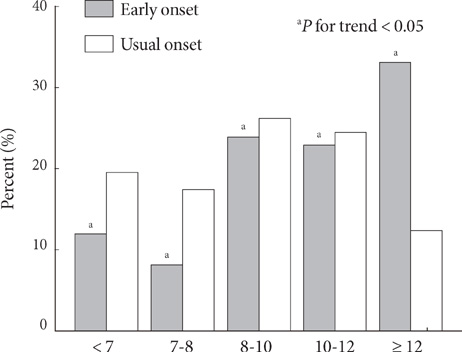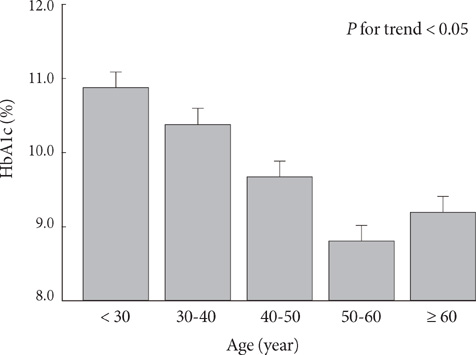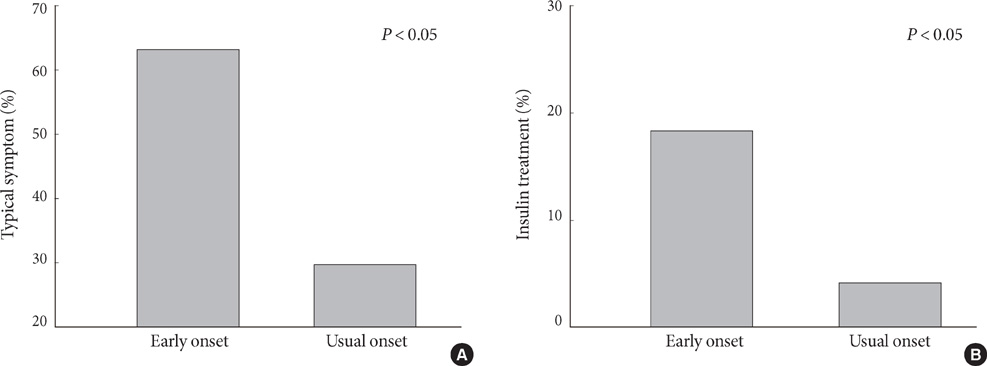Korean Diabetes J.
2010 Apr;34(2):119-125. 10.4093/kdj.2010.34.2.119.
The Clinical Characteristics of the Newly Diagnosed Early Onset (< 40 Years Old) Diabetes in Outpatients' Clinic
- Affiliations
-
- 1Department of Endocrinology and Metabolism, CHA University College of Medicine, Seongnam, Korea. ywcho@cha.ac.kr
- KMID: 2222386
- DOI: http://doi.org/10.4093/kdj.2010.34.2.119
Abstract
- BACKGROUND
The prevalence of type 2 diabetes in young adults and adolescents has increased in the last decade according to the increasing obese population. The aim of this study was to examine the clinical characteristics of patients diagnosed with diabetes mellitus before the age of 40 years as compared with patients diagnosed at older ages.
METHODS
This was a cross-sectional, retrospective study using data from 350 diabetic patients who were diagnosed with diabetes in an outpatient setting between January 2005 and December 2007. Patients were diagnosed according to the criteria set forth by the American Diabetes Association. We examined the clinical characteristics and laboratory data of the patients through review of medical records and compared the early-onset diabetic patients (< 40 years old) and the usual-onset diabetic patients (> or = 40 years old).
RESULTS
The frequency of early-onset diabetes and usual-onset diabetes were 31.1% (n=109) and 68.9% (n=241), respectively. The early-onset diabetic patients more often had a positive family history of diabetes; higher HbA1c, fasting glucose, and postprandial glucose levels; experienced typical symptoms more frequently; had microalbuminuria more frequently; and required insulin therapy as initial treatment more frequently as compared to usual-onset diabetic patients, and these differences were significant. Conversely, hypertension was significantly more common in the usual-onset diabetic patients.
CONCLUSION
It could be concluded that we should control early onset diabetes more strictly to prevent its complication because early onset diabetic patients represented more severe hyperglycemia and had more prevalent microalbuminuria.
Keyword
MeSH Terms
Figure
Cited by 2 articles
-
Questionnaire-based Survey of Demographic and Clinical Characteristics, Health Behaviors, and Mental Health of Young Korean Adults with Early-onset Diabetes
Ji In Park, Hyunjeong Baek, Sang-Wook Kim, Ji Yun Jeong, Kee-Ho Song, Ji Hee Yu, Il Seong Nam-Goong, Eun-Hee Cho
J Korean Med Sci. 2021;36(26):e182. doi: 10.3346/jkms.2021.36.e182.Characteristics of Glycemic Control and Long-Term Complications in Patients with Young-Onset Type 2 Diabetes
Han-sang Baek, Ji-Yeon Park, Jin Yu, Joonyub Lee, Yeoree Yang, Jeonghoon Ha, Seung Hwan Lee, Jae Hyoung Cho, Dong-Jun Lim, Hun-Sung Kim
Endocrinol Metab. 2022;37(4):641-651. doi: 10.3803/EnM.2022.1501.
Reference
-
1. Wild S, Roglic G, Green A, Sicree R, King H. Global prevalence of diabetes: estimates for the year 2000 and projections for 2030. Diabetes Care. 2004. 27:1047–1053.2. King H, Aubert RE, Herman WH. Global burden of diabetes, 1995-2025: prevalence, numerical estimates, and projections. Diabetes Care. 1998. 21:1414–1431.3. Kim SM, Lee JS, Lee J, Na JK, Han JH, Yoon DK, Baik SH, Choi DS, Choi KM. Prevalence of diabetes and impaired fasting glucose in Korea: Korean National Health and Nutrition Survey 2001. Diabetes Care. 2006. 29:226–231.4. Korea National Statistical Office. Annual report on the cause of death statistics, 2003. 2004. Daejeon: Korea National Statistical Office.5. Mokdad AH, Serdula MK, Dietz WH, Bowman BA, Marks JS, Koplan JP. The spread of the obesity epidemic in the United States, 1991-1998. JAMA. 1999. 282:1519–1522.6. Mokdad AH, Ford ES, Bowman BA, Nelson DE, Engelgau MM, Vinicor F, Marks JS. Diabetes trends in the U.S.: 1990-1998. Diabetes Care. 2000. 23:1278–1283.7. Rhee BD. Epidemiological characteristics of diabetes mellitus among Korean population. J Korean Diabetes Assoc. 2003. 27:173–178.8. The effect of intensive treatment of diabetes on the development and progression of long-term complications in insulin-dependent diabetes mellitus: the Diabetes Control and Complications Trial Research Group. N Engl J Med. 1993. 329:977–986.9. Stratton IM, Adler AI, Neil HA, Matthews DR, Manley SE, Cull CA, Hadden D, Turner RC, Holman RR. Association of glycaemia with macrovascular and microvascular complications of type 2 diabetes (UKPDS 35): prospective observational study. BMJ. 2000. 321:405–412.10. Ohkubo Y, Kishikawa H, Araki E, Miyata T, Isami S, Motoyoshi S, Kojima Y, Furuyoshi N, Shichiri M. Intensive insulin therapy prevents the progression of diabetic microvascular complications in Japanese patients with non-insulin-dependent diabetes mellitus: a randomized prospective 6-year study. Diabetes Res Clin Pract. 1995. 28:103–117.11. Hillier TA, Pedula KL. Complications in young adults with early-onset type 2 diabetes: losing the relative protection of youth. Diabetes Care. 2003. 26:2999–3005.12. Chuang LM, Soegondo S, Soewondo P, Young-Seol K, Mohamed M, Dalisay E, Go R, Lee W, Tong-Yuan T, Tandhanand S, Nitiyanant W, The-Trach M, Cockram C, Jing-Ping Y. Comparisons of the outcomes on control, type of management and complications status in early onset and late onset type 2 diabetes in Asia. Diabetes Res Clin Pract. 2006. 71:146–155.13. Krakoff J, Lindsay RS, Looker HC, Nelson RG, Hanson RL, Knowler WC. Incidence of retinopathy and nephropathy in youth-onset compared with adult-onset type 2 diabetes. Diabetes Care. 2003. 26:76–81.14. American Diabetes Association. Diagnosis and classification of diabetes mellitus. Diabetes Care. 2008. 31:Suppl 1. S55–S60.15. Matthews DR, Hosker JP, Rudenski AS, Naylor BA, Treacher DF, Turner RC. Homeostasis model assessment: insulin resistance and beta-cell function from fasting plasma glucose and insulin concentrations in man. Diabetologia. 1985. 28:412–419.16. Kim HY, Lee CJ, Kang SJ, Hong HK, Baik JM, Oh YB, Jeong DK, Yoo SJ, Kim SM, Kim DS, Kim EJ. A clinical study on Korean 235 diabetes under the age of 35 years. J Korean Diabetes Assoc. 1994. 18:322–329.17. Park M, Kang YI, Chon S, Oh SJ, Woo JT, Kim SW, Kim JW, Kim YS. The clinical characteristics of young onset diabetes according to etiology based classification. J Korean Diabetes Assoc. 2006. 30:190–197.18. Aguilar-Salinas CA, Rojas R, Gomez-Perez FJ, Garcia E, Valles V, Ríos-Torres JM, Franco A, Olaiz G, Sepülveda J, Rull JA. Prevalence and characteristics of early-onset type 2 diabetes in Mexico. Am J Med. 2002. 113:569–574.19. Oh JY, Lim S, Kim DJ, Kim NH, Moon SD, Jang HC, Cho YM, Song KH, Park KS. The diagnosis of diabetes mellitus in Korea: a pooled analysis of four community-based cohort studies. Diabet Med. 2007. 24:217–218.20. Yoon KH, Lee JH, Kim JW, Cho JH, Choi YH, Ko SH, Zimmet P, Son HY. Epidemic obesity and type 2 diabetes in Asia. Lancet. 2006. 368:1681–1688.21. Ramachandran A, Mary S, Yamuna A, Murugesan N, Snehalatha C. High prevalence of diabetes and cardiovascular risk factors associated with urbanization in India. Diabetes Care. 2008. 31:893–898.22. Gu D, Reynolds K, Duan X, Xin X, Chen J, Wu X, Mo J, Whelton PK, He J. Prevalence of diabetes and impaired fasting glucose in the Chinese adult population: International Collaborative Study of Cardiovascular Disease in Asia (InterASIA). Diabetologia. 2003. 46:1190–1198.23. Shim WS, Kim HJ, Kim SK, Han SJ, Kang ES, Rhee YM, Ahn CW, Lim SK, Kim KR, Lee HC, Cha BS. The association of family history of diabetes and obesity in the development of type 2 diabetes. J Korean Diabetes Assoc. 2005. 29:540–547.
- Full Text Links
- Actions
-
Cited
- CITED
-
- Close
- Share
- Similar articles
-
- Peripheral Nerve Abnormalities in Patients with Newly Diagnosed Type I and II Diabetes Mellitus
- Management of Early-Onset Type 2 Diabetes
- Comparison of Age of Onset and Frequency of Diabetic Complications in the Very Elderly Patients with Type 2 Diabetes
- A Clinical Study on Diabetic Keteoacidosis
- The Clinical Characteristics of Young Onset Diabetes According to Etiology Based Classification




